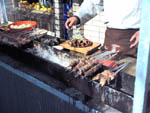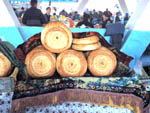| Write me or send me your recept |
[ Main page ] [ Salats ] [ Appetizers ] [ Soups ] [ Main courses ] [ Pastas and Breads ]
 Though the nation of Uzbekistan
is relatively new, gaining independence only after the dissolution of the Soviet Union in
1991, their culture is one of the more ancient and refined in Central Asia. One
particularly distinctive and well-developed aspect of Uzbek culture is their cuisine.
Unlike their nomadic neighbours, the Uzbeks have had a settled civilization for centuries.
Between the deserts and mountains, in the oases and fertile valleys, they cultivated grain
and domesticated livestock. The resulting abundance of produce allowed them to express
their strong tradition of hospitality, which in turn enriched their cuisine.
Though the nation of Uzbekistan
is relatively new, gaining independence only after the dissolution of the Soviet Union in
1991, their culture is one of the more ancient and refined in Central Asia. One
particularly distinctive and well-developed aspect of Uzbek culture is their cuisine.
Unlike their nomadic neighbours, the Uzbeks have had a settled civilization for centuries.
Between the deserts and mountains, in the oases and fertile valleys, they cultivated grain
and domesticated livestock. The resulting abundance of produce allowed them to express
their strong tradition of hospitality, which in turn enriched their cuisine. In
general, mutton is the preferred source of protein in the Uzbek diet. Fatty-tailed sheep
are prized not only for their meat and fat as a source of cooking oil, but for their wool
as well. Beef and horsemeat are also consumed in substantial quantities. Camel and goat
meat are less common. The wide array of breads, leavened and unleavened, is a staple for
the majority of the population. Flat bread, or nan, is usually baked in tandoor ovens, and
served with tea, not to mention at every meal. Some varieties are prepared with onions or
meat in the dough, others topped with sesame seeds or kalonji.
In
general, mutton is the preferred source of protein in the Uzbek diet. Fatty-tailed sheep
are prized not only for their meat and fat as a source of cooking oil, but for their wool
as well. Beef and horsemeat are also consumed in substantial quantities. Camel and goat
meat are less common. The wide array of breads, leavened and unleavened, is a staple for
the majority of the population. Flat bread, or nan, is usually baked in tandoor ovens, and
served with tea, not to mention at every meal. Some varieties are prepared with onions or
meat in the dough, others topped with sesame seeds or kalonji. Palov, the Uzbek version of pilaff, is the flagship of their cookery.
It consists mainly of fried and boiled meat, onions, carrots and rice; with raisins,
barberries, chickpeas, or fruit added for variation. Uzbek men pride themselves on their
ability to prepare the most unique and sumptuous palov. The oshpaz, or master chef, often
cooks palov over an open flame, sometimes serving up to 1000 people from a single cauldron
on holidays or occasions such as weddings. It certainly takes years of practice with no
room for failure to prepare a dish, at times, containing up to 100 kilograms of rice.
Palov, the Uzbek version of pilaff, is the flagship of their cookery.
It consists mainly of fried and boiled meat, onions, carrots and rice; with raisins,
barberries, chickpeas, or fruit added for variation. Uzbek men pride themselves on their
ability to prepare the most unique and sumptuous palov. The oshpaz, or master chef, often
cooks palov over an open flame, sometimes serving up to 1000 people from a single cauldron
on holidays or occasions such as weddings. It certainly takes years of practice with no
room for failure to prepare a dish, at times, containing up to 100 kilograms of rice. Tea is revered in the finest oriental traditions. It is offered first
to any guest and there exists a whole subset of mores surrounding the preparation,
offering, and consuming of tea. Green tea is the drink of hospitality and predominant.
Black tea is preferred in Tashkent, though both teas are seldom taken with milk or sugar.
An entire portion of their cuisine is dedicated solely to tea drinking. Some of these
include samsa, bread, halva, and various fried foods.
Tea is revered in the finest oriental traditions. It is offered first
to any guest and there exists a whole subset of mores surrounding the preparation,
offering, and consuming of tea. Green tea is the drink of hospitality and predominant.
Black tea is preferred in Tashkent, though both teas are seldom taken with milk or sugar.
An entire portion of their cuisine is dedicated solely to tea drinking. Some of these
include samsa, bread, halva, and various fried foods. gathering place for social interaction and
fraternity. Robed Uzbek men congregate around low tables centered on beds adorned with
ancient carpets, enjoying delicious palov, kebab and endless cups of green tea.
gathering place for social interaction and
fraternity. Robed Uzbek men congregate around low tables centered on beds adorned with
ancient carpets, enjoying delicious palov, kebab and endless cups of green tea.The recipts given here is for the family which consist of 4-5 men.